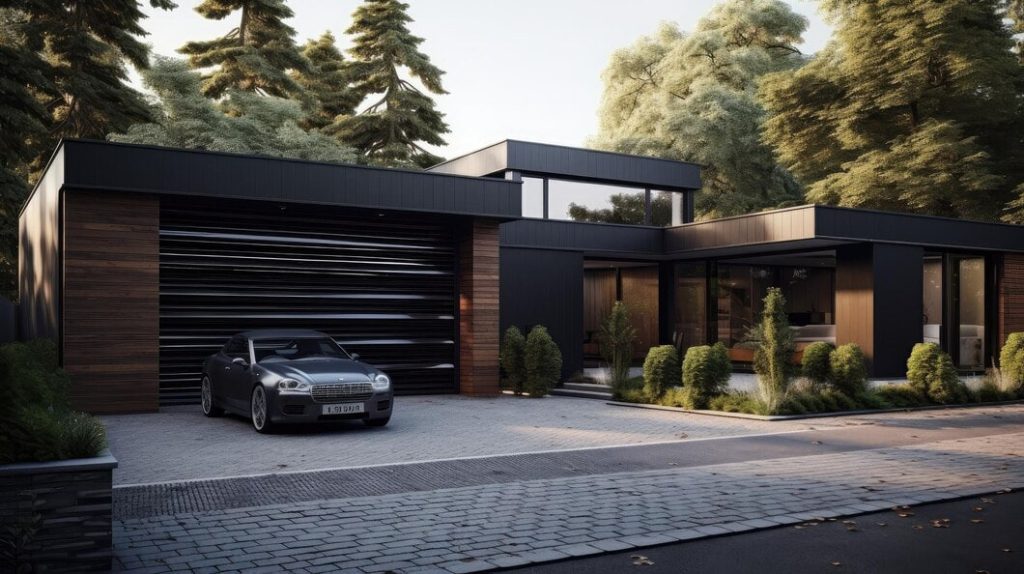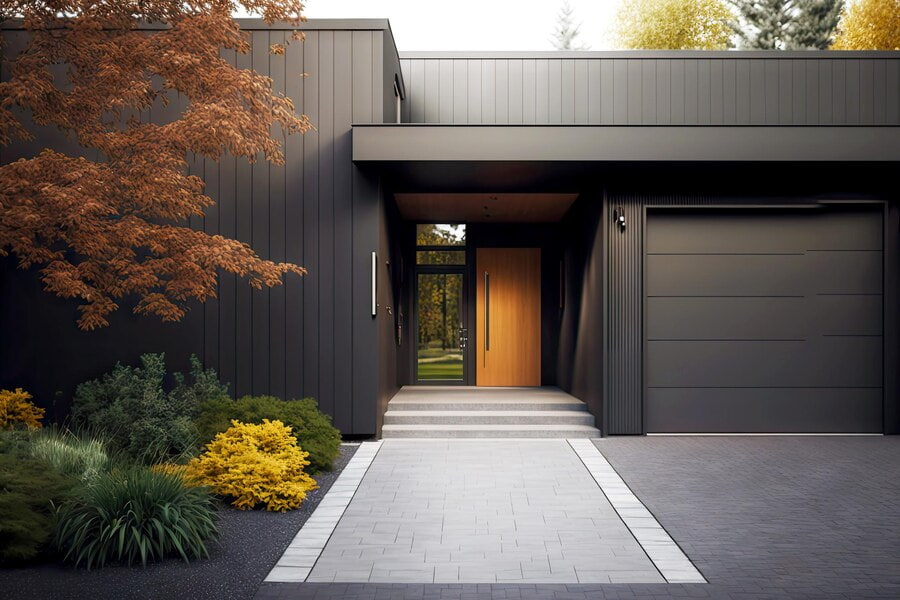5 Solutions for Your Steep Driveway
29 May, 2024
- The Issues of Steep Driveway
- Safety Hazards
- Limited Accessibility
- Erosion and Drainage Problems
- How to Fix a Steep Driveway – 5 Effective Solutions
- Solution 1: Regrading and Retaining Walls
- Solution 2: Gravel or Paved Alternatives
- Solution 3: Using Rubber Surfaces
- Solution 4: Installing a Driveway Heating System
- Solution 5: Implementing Effective Drainage Solutions
- Finding the Right Solution for Your Steep Driveway
From safety hazards to erosion concerns – steep driveways pose countless challenges for homeowners with them. If you are one of them, it is crucial to find the optimal solution that would ensure the safety, accessibility, and durability of your front-house area. In this article, we will explore the five most effective solutions for steep driveways.

The Issues of Steep Driveway
Safety Hazards
The steep gradient of a driveway makes it challenging for vehicles to move and pedestrians to navigate on it. Not to mention the challenges it poses before impaired individuals, who can find it particularly tricky to walk on. Not only does this limited accessibility significantly detract from the enjoyment of having such a house, but it can drastically devaluate the property value if you ever decide to sell it.
Limited Accessibility
The steep gradient of a driveway makes it challenging for vehicles to move and pedestrians to navigate on it. Not to mention the challenges it poses before impaired individuals, who can find it particularly tricky to walk on. Not only does this limited accessibility significantly detract from the enjoyment of having such a house, but it can drastically devaluate the property value if you ever decide to sell it.
Erosion and Drainage Problems
Runoff from rain or melting snow tends to erode the driveway surface, not only deteriorating your driveway’s looks but also causing structural damage and forming cracks, dents, and bumps. In addition, water pooling, caused by poor drainage, can cause micro-flooding, exacerbating the issue and expanding the damage to the surrounding area, making the accessibility even worse.
How to Fix a Steep Driveway - 5 Effective Solutions
After all of the mentioned above, you might be asking yourself, “How do I fix a steep driveway near my home?”. Fortunately, a sloped driveway is not a verdict, so let’s delve into the five most effective ways of dealing with it.

Solution 1: Regrading and Retaining Walls
Limiting the sides of the driveway with grading and retaining walls is the most common way how to fix a steep driveway. It fixates the surface and serves as a pillar for the soil mass.
Pros
- Effectiveness: walls have been shown to be among the most effective options for correcting the driveway’s slope, reducing steepness, and, consequently, improving safety. Moreover, many walls allow for the installation of entrance gates, ensuring extra security for your property.
- Soil Stabilization: adding extra retaining to the soil regrading walls helps stabilize the solid and prevent erosion in the long run.
- Aesthetics: Retaining walls help structure the landscape, adding to its aesthetic appeal. Moreover, they are customizable in size, pattern, and color blocks, blending into almost any exterior style.
Cons
- Cost: the upfront cost of installation, equipment, and materials can be higher than that of other solutions.
- Challenging Installation: regrading walls doesn’t allow DIY installation, meaning professional assistance is required.
- Permission: certain states and counties demand you receive permits from local authorities before installing retaining walls on your property.

Solution 2: Gravel or Paved Alternatives
Another effective steep driveway solution is covering the surface with gravel or pavers. While offering superior traction and aesthetics, they make for a relatively easy option in terms of installation.
Pros
- Traction and Stability: both gravel and pavers provide excellent traction and stability, making them comfortable and safe to walk on, even in adverse weather conditions.
- Affordability: gravel and pavers are a cost-effective solution, both in terms of materials and installation.
- Aesthetics: the materials are deeply customizable, allowing homeowners to pick the size, color, shape, and pattern of the grain to match their aesthetic preferences.
Cons
- Maintenance: gravel and pavers are not the most low-maintenance materials, requiring regular upkeep. For instance, gravel demands frequent raking and refilling, while pavers tend to form cracks that must be repaired.
- Regarding Over Time: gravel may shift or erode, calling for even more upkeep.
- Deterioration: pavers are susceptible to heavy vehicle traffic, which can lead to cracks or severe deterioration.
Solution 3: Using Rubber Surfaces
Rubber has become one of the most versatile surfacing materials, frequently found in playgrounds, gyms, basements, running tracks, and many other places. It can also be an excellent choice for a steep driveway, though it is crucial to consider all of its pros and cons.
Pros
- Traction: rubber offers exceptional traction and slip resistance, even in icy or wet conditions.
- Durability: rubber is durable and resilient to temperature fluctuations, moisture, impact, and heavy foot traffic, requiring little to no maintenance.
- Eco-friendliness: most rubber is made of either natural or recycled materials, making it eco-friendly.
Cons
- Installation Cost: although rubber costs practically nothing to maintain, the upfront installation price is higher than other options.
- Aesthetic Choices: Compared to other materials, rubber has limited color and texture choices, making it harder to fit into confident design choices.
- Deterioration: rubber tends to deteriorate under heavy vehicle traffic, making it not the most suitable choice for certain driveways.
Solution 4: Installing a Driveway Heating System
Many driveways (not only steep) suffer from snow and ice buildup in winter, making them practically impossible to walk or drive on. One of the best solutions is installing a driveway heating system that will melt all the snow and ice that gets on its surface.
Pros
- Ice- and Snow-Resistance: you can forget about snowy or icy driveways, ensuring secure vehicle access the whole year. Moreover, driveway heating systems work automatically, eliminating the need to remove snow and ice manually.
- Versatility: such systems can be integrated into existing driveways or installed during the construction of new ones.
Cons
- Installation Cost: heating systems call for higher upfront equipment and installation costs.
- Energy dependence: heat exchangers in driveway heating systems don’t work without electricity, meaning you must set up uninterrupted electrical current or an alternative energy source.
- Maintenance: the cost of maintenance and repairs that come over time may be significant.
Solution 5: Implementing Effective Drainage Solutions
Last but not least, you can install a drainage system in your driveway. It can help extract water from your driveway, leading to better traction and more extended service.
Pros
- Water resistance: adequate drainage can significantly reduce the risk of pooling and erosion of soil, preserving its integrity. In addition to that, drainage helps manage uncontrollable water flows during heavy rains or snow melting, keeping the water away from your driveway. It has been shown that a properly installed driveway drainage has a load capacity of up to 1.25 tons, protecting the surface from extensive water damage.
- Aesthetics: drainage can be integrated into the landscape, greatly enhancing its natural aesthetics.
Cons
- Tricky Installation: drainage systems are complex and challenging to install, meaning that thorough preparation, planning, excavation, and professional execution are crucial. Not only is it particular to disrupt the existing landscape, but it is also way more costly than most other options.
- Maintenance: Regular cleaning and removing mold and weeds are crucial to keep drainage systems unobstructed and functional.
Finding the Right Solution for Your Steep Driveway
When selecting the best steep driveway fix, consider cost-effectiveness, durability, and compatibility with your property’s aesthetics and functional requirements. Consulting with experienced professionals and exploring different options will help you identify the most suitable solution to enhance safety, accessibility, and longevity while requiring minimal maintenance. Whether regarding the terrain, opting for paved or gravel driveway, investing in innovative technologies like heated driveways, or implementing effective drainage solutions, prioritizing proper installation and ongoing maintenance will ensure optimal performance and satisfaction for homeowners in suburban areas.
